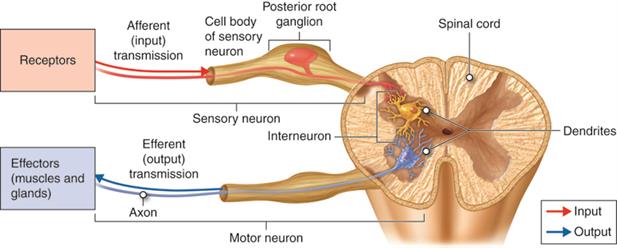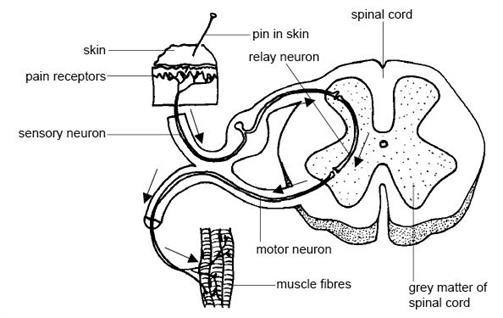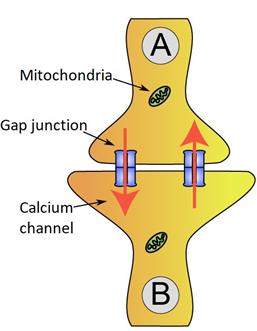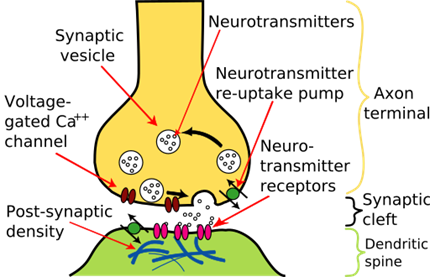
PUMPA - SMART LEARNING
எங்கள் ஆசிரியர்களுடன் 1-ஆன்-1 ஆலோசனை நேரத்தைப் பெறுங்கள். டாப்பர் ஆவதற்கு நாங்கள் பயிற்சி அளிப்போம்
Book Free DemoBased on function, neurons are of three types.
- Sensory neurons
- Motor neurons
- Relaying neurons

The action of sensory and motor neuron
1. Sensory neurons/Afferent neurons - These neurons transmit nerve impulses by connecting sensory or receptor cells or organs to the central nervous system. Dendrite terminals become modified to form receptors.
2. Motor/efferent neurons - They transmit impulses from the central nervous system to effectors such as muscles and glands. A neuromuscular junction is formed when the axon terminals meet the motor endplate.
3. Relaying neurons - They occur between the sensory and motor neurons in the brain and spinal cord for the distant transmission of nerve impulses.

Relay neurons
Transmission of the nerve impulse
The synapse, often known as a "gap," is the point at which information is passed from one neuron to the next. Synapses are formed when the axon of one neuron connects to the dendrite spine of another. A synapse is formed by the membranes of a presynaptic and postsynaptic neuron that may or may not be split by a synaptic cleft.
Transmission of signals through synapsis
The nerve impulse is transmitted in the form of the electrochemical wave from one neuron to another through junctions called synapsis.
Note: The neuron that transmits the signal is known as the presynaptic neuron, while the neuron that receives it is known as the postsynaptic neuron.
Pathway of nerve impulses
The information is received via chemical reaction at the dendritic tip of a nerve cell, which results in an electrical impulse.
\(\huge{\downarrow}\)
This electrical impulse travels from the dendrite to the cell body and at the axon terminals.
\(\huge{\downarrow}\)
The electrical impulse at the axon's end triggers the release of chemicals.
\(\huge{\downarrow}\)
These chemicals cross the synapse and initiate a similar electrical impulse in the following neuron's dendrite.
\(\huge{\downarrow}\)
Finally, a similar synapse permits such impulses to be delivered from neurons to other cells like glands and muscle cells.
- Electrical synapsis
- Chemical synapsis
1. Conduction of nerve impulse through an electrical synapse
Electrical synapses have a very different mode of neurotransmission than chemical synapses. In an electrical synapse, the presynaptic and postsynaptic membranes are relatively close together. These synapses allow electrical current to travel straight from one neuron to the next.
A structural and electrically conductive link is formed between two neighbouring neurons at a gap junction, a tiny gap between the pre and postsynaptic neurons. Current can flow directly from one cell to the next through gap junctions. In addition to the ions that transport the current, other molecules, such as ATP, can also pass through the wide gap junction pores. Electrical synapses are rare in our system.

Electrical synapsis
2. Conduction of nerve impulse through a chemical synapse
Henry Dale discovered the method of chemical transmission across synapses in \(1936\). He was awarded Nobel prize along with Otto Loewi for their research on chemical synaptic transmission.

The chemical synapse between two neurons
1. In the chemical synapse, the membranes of the pre and postsynaptic neurons are separated by a fluid-filled gap called the synaptic cleft. The transmission of impulses at synapses is facilitated by chemicals known as neurotransmitters. Neurotransmitters transmit information from a pre-synaptic sending neuron to a post-synaptic receiving neuron.
2. Vesicles containing neurotransmitters are seen in the axon terminals of the neuron. Neurotransmitters can be either excitatory, E.g. Acetylcholine or inhibitory, E.g. GABA (Gamma-aminobutyric acid). Acetylcholine and noradrenaline are the two major neurotransmitters in the nervous system of invertebrates.
3. A nerve impulse activatesvoltage-gated calcium channels in the cell membrane as it reaches the axon terminal. Calcium ions, which are considerably more abundant outside the neuron than inside, rush into the cell.
4. The calcium ions cause the synaptic vesicles to move to the knob's surface. Synaptic vesicles then fuse with the axon terminal membrane, allowing neurotransmitter to enter the synaptic cleft. The synaptic vesicles then return to the synaptic knob's cytoplasm to be refilled with neurotransmitters.
5. The release neurotransmitters bind to receptors on the postsynaptic membrane. The activation of postsynaptic receptors causes ion channels in the cell membrane to open or close. The newly created potential could be either excitatory or inhibitory. The transmission of impulses over an electrical synapse is faster than the transmission of impulses across a chemical synapse, as we have shown.
Conduction nerve impulses
Reference:
https://commons.wikimedia.org/wiki/File:1212_Sensory_Neuron_Test_Water.jpg
https://commons.wikimedia.org/wiki/File:Imgnotra%C3%A7at_arc_reflex_eng.svg
https://breakingmuscle.com/fitness/the-neurological-benefits-of-clean-and-snatch-complexes
https://pixabay.com/vectors/red-science-diagram-cell-neuron-41524/
https://commons.wikimedia.org/wiki/File:Synapse_Illustration2_tweaked.svg
https://commons.wikimedia.org/wiki/File:Synapse_diag2.png